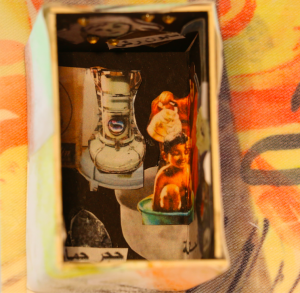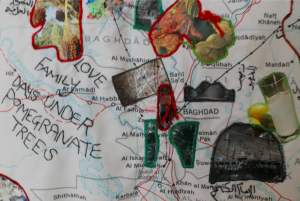’I feel that art is the best way to express ourselves as refugees and forced immigrants, and it helps us keep our identity alive for the new Iraqi generation.’
Rana Ibrahim
In 2021, the Visualising War and Peace podcast interviewed Iraqi artist and museum curator Rana Ibrahim. Rana’s childhood and early adulthood were dominated by conflict, and she ended up seeking refuge as a forced migrant in the UK following the US-led invasion of Iraq in 2003. After settling in Oxford, she founded the Iraqi Women, Art and War Group, a community project that gives women who have been displaced by conflict an opportunity to process their experiences and tell their stories through art.

The artwork they have produced has been curated into an exhibition entitled ‘Of Ordinary Things’. Representations of conflict often focus on fighting, destruction, trauma and death. The pieces in this exhibition are different: they aim to capture the everyday, the lives that people try to live in the shadow of conflict, and above all how women experience war – both at the time and afterwards, when rebuilding their lives far from the physical conflict zone. At the heart of the exhibition is a ‘Wall of Memories’. For refugees, remembering can be both painful and beautiful, a journey of nostalgia but also a reminder of suffering and loss.
This ‘Wall of Memories’ combines both aspects. In the background are some exquisite paintings of date palms, one of the most recognisable trees in Iraq and the first thing that many Iraqi children learn to draw. The date palm represents life, sweetness, beauty and strength – and, as a feminine noun, it particularly evokes the everyday resilience of the women of Iraq.

Superimposed on these date palms are lots of little ‘boxes of memories’, each containing a detailed image which evokes something of each artist’s former life in Iraq. Some boxes depict war, fear, separation and anxiety; but others contain happier memories – such as children’s bath time in front of the stove (left). Taken together, the snapshots in this piece tell a much broader story about life in a war zone than most other war art. They represent ordinary things alongside the extraordinary, foregrounding the many different ways in which those caught up in conflict try to ‘soldier on’.
Memory is an important theme in the exhibition; and one of Rana’s favourite artistic methods – collage – is particularly suited to bringing memories to life, piece by piece and layer by layer, in a complex jigsaw of different colours and textures. Here is one example of her collage work, which she hopes will soon be on display in the Ashmolean Museum; two more examples can be seen here, both made in tribute to her father who was killed in a terrorist attack in Iraq in 2009. As Rana explains in the podcast below, her own artwork has helped her to rediscover her identity after leaving Iraq, as she has come to terms with her separation from loved ones and processed her loss of the home she had to leave behind.
Take, for example, her ‘Map of Iraq’. The map has been printed on a cloth bordered with date palms, and on it Rana has stitched words and added images to capture memories of her life in Iraq, memories which she fears are fading after such a long time away. The piece is not finished: as the exhibition goes on tour, visitors will be invited to add their own memories of Iraq. Art here functions not only to keep personal memories alive but to build community amongst displaced people. Rana hopes that her artwork will also establish dialogues with others, sparking conversations about forced displacement, what it is like to be a refugee from a war zone, what war itself is like, and why it must stop. Her art is not simply about representation: it is a form of activism (or ‘artivism’), an act of solidarity with others who have suffered through conflict and a conscious form of storytelling that she hopes might change the world for the better.


‘It is very hard to leave our countries due to war and feel the impacts of displacement. Therefore the art helped me to cope with the new culture and the environment.’
Lubna, a member of the Iraqi Women, Art and War Group

Rana has helped many others to process their experiences of conflict and forced migration – both through creating art, individually and collectively, and through staging exhibitions, workshops and community events where art has helped stimulate conversations about displacement and belonging. Art has proved a valuable tool not just in helping forced migrants to stay connected with cultural traditions from their countries of origin but also in providing pathways to connect with new cultural traditions. And it has been valuable in generating dialogue and understanding between forced migrants and people with no lived experience of displacement. For a sample of their creative work in this space, you can explore an array of amazing art developed by the Iraqi Women, Art and War Group during outreach activities for Refugee Week.

If you want to learn more about Rana Ibrahim’s story and the work of the Iraqi Women, Art and War group, you can listen to the full podcast episode below. The exhibition ‘Of Ordinary Things’ was on display in the Museum of Oxford in 2022, before moving to the Soldiers of Oxfordshire Museum.
The group is fundraising to continue touring the exhibition and developing their artivism for the future: if you are able, you can donate here. You can view more of the artwork and some short films about its creation at www.iwaw19.com.
IWAW website| TikTok IWAW, |IWAW YouTube
IWAW Twitter| IWAW Facebook |IWAW Instagram|t:07515273808